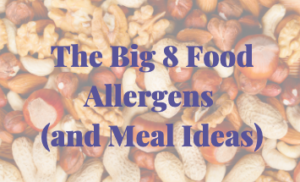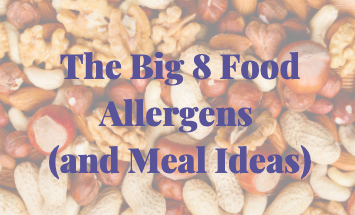The Big 8 Food Allergens (and Meal Ideas)
 Did you know that nearly 32 million Americans have some sort of food allergy? Food allergies can be very dangerous, they are different from food intolerances because they involve an immune response that can be life-threatening.
Did you know that nearly 32 million Americans have some sort of food allergy? Food allergies can be very dangerous, they are different from food intolerances because they involve an immune response that can be life-threatening.
May is National Food Allergy Awareness Month, and this week of May 10th through May 15th is Awareness Week. The color teal is used to help spread awareness, so be sure to show your teal love!
There are 8 common foods that are known to cause about 90% of food allergies. If you or your child have a food allergy, you are aware of how important it is to carefully read the nutrition facts label before eating any food product. Most food labels will explicitly list if they contain any of the big 8 food allergens, however, you should always thoroughly read the ingredient list.
A great way to avoid foods that could be contaminated with an allergen is by cooking at home. Many wonderful recipes specifically avoid using ingredients that are common allergens.
The Big 8 Food Allergens:
It’s not uncommon for someone to be allergic to one or more of the big 8 food allergens, some people may be allergic to all 8! These allergens are:
1. Wheat – An allergy to wheat and other cereals is usually seen in childhood and can be outgrown. Reactions can range from digestive upset or skin reactions to anaphylactic shock. Celiac Disease (CD) is a specific reaction to the protein fraction gluten. Those affected by CD typically adopt a gluten-free diet as a treatment. Eating gluten-free is now easier than ever with new gluten-free products continually popping up in the marketplace.
2. Milk – The proteins casein and whey in milk are often the culprits of this food allergy. Symptoms of an allergic reaction to milk include digestive upset and difficulty breathing. Milk products can be found in a variety of foods such as drinking milk, yogurt, cheese, butter, and a variety of baked goods and processed foods. A great alternative to dairy milk is plant-based milk such as rice or oat milk.
3. Peanuts – Peanuts, which are actually a legume, may be one of the most serious of the food allergies. Reactions can range from mild to severe. Some individuals need to carry an EpiPen as a precaution in case they consume traces of peanuts by accident.
4. Eggs – An allergy to eggs is most often seen in children but is commonly outgrown within the first six years of life. Eggs are often included in a variety of baked goods and processed foods so it’s important to check food labels. Eggs can be replaced in many baking recipes with applesauce or mashed bananas.
5. Fish – The allergic reaction to fish often includes symptoms in the digestive tract and skin. Some reactions can be severe enough to cause anaphylactic shock. Most reactions are caused by the muscle protein parvalbumin, which is found in many different species.
6. Legumes – Legumes are a family of foods including soybeans, chickpeas, lentils, peas, and more. Soybeans and its products are used in many foods as part of processed foods or in more whole food-like forms such as tofu or tempeh. Reactions can range from mild to severe life-threatening.
7. Shellfish – Crustacean shellfish is a group of sea animals including crab, lobster, shrimp, and prawns. This allergy affects many children and adults. Reactions can range from symptoms in the mouth to a whole-body life-threatening reaction. Shellfish can be found in their whole form or mixed into processed foods such as sauces and salad dressings.
8. Tree Nuts – This group includes a wide range of different nuts from walnuts to pecans to hazelnuts. Allergic reactions often involve systemic or respiratory reactions and sometimes fatal anaphylactic shock. Strict avoidance of nuts in food is extremely important, so be sure to check and doublecheck food labels.
.
Recipe Ideas Without the Big 8 Allergens:
If you are cooking for a large group of people and you do not know their specific food allergies, it is best to avoid any recipes that utilize the big 8. Here are some ideas:
- Chicken, Quinoa, and Spinach Soup – A delicious hearty meal filled with plenty of protein, fiber, and other important nutrients.
- Black Bean Burgers on Gluten-Free Buns – A quick and easy meal that can be prepped days ahead for when your schedule is busy.
- Grilled Corn and Avocado Salad – The perfect salad dish for a picnic during the summer.
- Three Bean Chili – A yummy bowl of flavor to satisfy your hunger and nourish your body.
- Mexican Beans and Rice – A simple but great go-to meal when you’re looking for something that’s easy to make and delicious at the same time.
- Spaghetti Squash Pad Thai – A plant-based spin on the beloved pad Thai, you’ll surely fall in love with this tasty variation.
Being informed about food allergies, whether you have them yourself or not, is a great idea. Now equipped with the basics, you can join in by helping to raise awareness with your loved ones.
Your Turn to Take Action: How will you celebrate National Food Allergy Awareness Week? Let me know in the comments below!


Wow, I never knew that fish allergens could get as bad as an anaphylactic shock depending on the person. This makes me think about how uncomfortable my kids get every time I try to serve them some fish they’ve never eaten before, and it’s not just how it tastes. The fact that they sometimes get itchy afterward makes me think that I should stop serving fish for now and look for an allergen testing center to help me find out what else they might be allergic to.